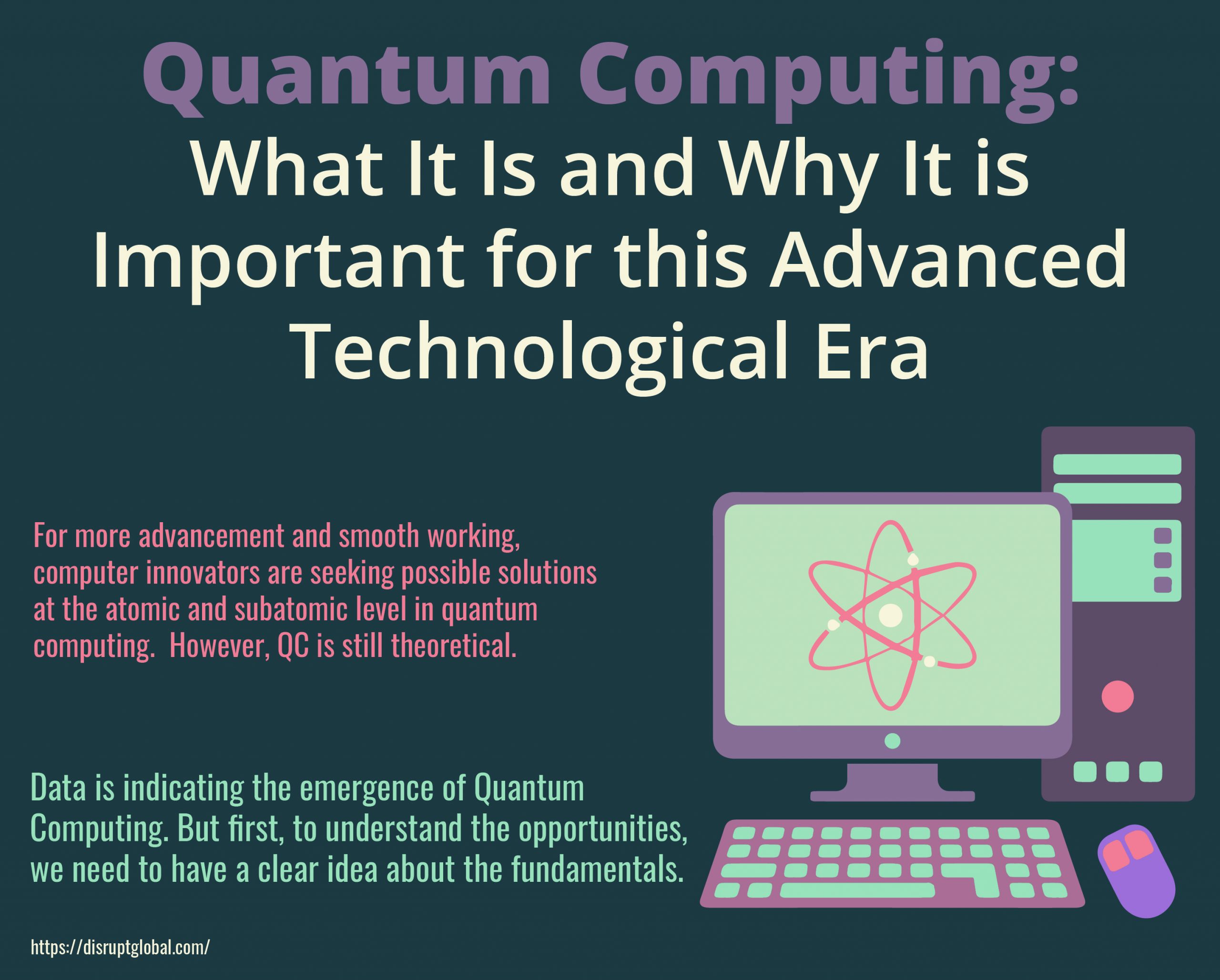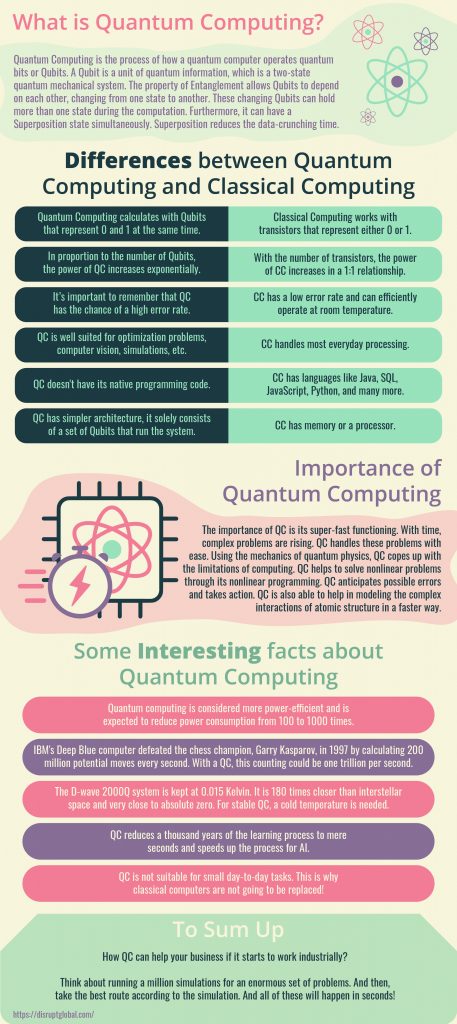
Quantum Computing: What It Is and Why It is Important for this Advanced Technological Era
Posted by. Disrupt Tech. August 3, 2021
Once, computers were nothing less than wonders. People were fascinated and wanted to see it with their eyes. With time, the computer has become an integral part of our everyday life.
Now we live in such an advanced life where the Classical Computer (CC) sometimes fails to support our demand. Hence, Quantum Computing (QC) is slowly becoming a focal point of interest, especially for the researchers.
At present, the transistors used in computers are as tiny as we can make them with existing technology. So for more advancement and smooth working, computer innovators are seeking possible solutions at the atomic and subatomic level in quantum computing.
However, QC is still theoretical. And so, futurists often joke that it will never be possible to apply QC in real life. But the data says otherwise! A report by McKinsey & Partner predicts that the global market value of the field of QC technology will be the US $1 trillion by 2035.
So, data is indicating the emergence of Quantum Computing. But first, to understand the opportunities, we need to have a clear idea about the fundamentals. In this article, we will focus on the basics of quantum computing.
What is Quantum Computing?
Academically, Quantum Computing is the process of how a quantum computer operates quantum bits or Qubits. A standard computer generally works using bits of information. Bits are like coins lying on a table.
Suppose a coin is on a table. It’s either Heads or Tails on top. Similarly, bits remain either in 0 or 1 state.
Qubits, however, is like a coin spinning in the air. These flying coins again can interact with other spinning coins. So, until the quantum operations are complete, none of them are heads or tails up.
A Qubitis a unit of quantum information, which is a two-state quantum mechanical system. The two different properties are entirely different from the concept of a classical computer.
The property of Entanglement allows Qubits to depend on each other. It changes the state of one Qubit to another. These changing Qubits can hold more than one state during the computation. Furthermore, it can have a Superposition state simultaneously, both in the 0 and 1 state. Four different scenarios can be created through this superposition at the same time. Superposition reduces the data-crunching time.
In the real world, the work with QC has already been started. Businesses like IBM and Amazon are using it right now on a small scale.
The question may arise, what specific tasks can QC perform that are not possible using the classical computer? Let’s address this question now.
Differences between Quantum Computing and Classical Computing
Quantum Computing calculates with Qubits that represent 0 and 1 at the same time, whereas Classical Computing works with transistors that represent either 0 or 1.
In proportion to the number of Qubits, the power of QC increases exponentially. On the contrary, with the number of transistors, the power of CC increases in a 1:1 relationship.
It’s important to remember that QC has the chance of a high error rate. Also, it needs to be kept ultra-cold. But CC has a low error rate and can efficiently operate at room temperature.
QC is well suited for optimization problems, computer vision, simulations, etc. Oftentimes, it is so complex that it is only used in scientific research and highly technological use cases. In contrast, CC handles most everyday processing.
QC doesn’t have its native programming code. So, it requires the development and implementation of particular algorithms. On the other hand, CC has languages like Java, SQL, JavaScript, Python, and many more.
Interestingly, QC has simpler architecture than classical computers. It doesn’t have memory or a processor. It solely consists of a set of Qubits that run the system.
Importance of Quantum Computing
The computer we use works in a binary system. They use transistors to store and retrieve data. Thanks to the miniaturization of electronic devices that allow this basic model to work amazingly for the last few decades.
It also allows making powerful computers by adding millions of transistors that are as small as 7 nm. But we are reaching a time when producing smaller transistors won’t be possible anymore.
The balance between small size and processing power will hamper the further addition of transistors. It might require a bigger device for accommodating those extra transistors. Tech researchers find it essential to replace the binary system altogether with a new concept that a QC is offering.
If we want to analyze the importance of QC, then the first thing that comes to mind is its super-fast functioning. In 2019, Google ran a calculation on a QC in just a few minutes that would otherwise take 10,000 years to complete for a CC. Apart from that, there are few areas where the importance of QC is noticeable.
With time, complex problems are rising. QC handles these problems with ease. These may include protein modeling and optimization of energy sources. Using the mechanics of quantum physics, QC copes up with the limitations of computing.
The classical computer is a good choice for restoring data and performing sequential operations. But it is difficult to find solutions to the problems based on its linear system. QC helps to solve nonlinear problems through its nonlinear programming.
Apart from that, QC solves the optimization problems so fast. QC anticipates possible errors and takes action. Researchers are now seeking efficient ways of training and testing models using large data. And nothing can be as suitable as QC to make the process faster.
QC is also able to help in modeling the complex interactions of atomic structure in a faster way. The calculation of these complex interactions limits Chemistry and material science.
Some Interesting facts about Quantum Computing
• Quantum computing is considered more power-efficient and is expected to reduce power consumption from 100 to 1000 times.
• IBM’s Deep Blue computer defeated the chess champion, Garry Kasparov, in 1997 by calculating 200 million potential moves every second. With a QC, this counting could be one trillion per second.
• The D-wave 2000Q system is kept at 0.015 Kelvin. It is 180 times closer than interstellar space and very close to absolute zero. That means, for stable QC, a cold temperature is needed.
• QC reduces a thousand years of the learning process to mere seconds and speeds up the process for AI.
• QC is not suitable for small day-to-day tasks. This is why classical computers are not going to be replaced!
To Sum Up –
After knowing all the facts and ideas about Quantum Computing, a question may come to mind how QC can help your business if it starts to work industrially? For the answer, think about running a million simulations for an enormous set of problems. And then, take the best route according to the simulation. And all of these will happen in seconds!

